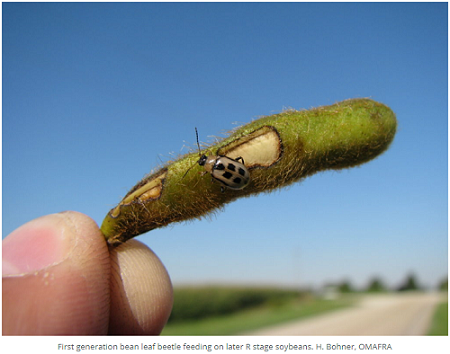Bean leaf beetles (BLB) have reached the pod feeding threshold in some IP soybean fields this week. Despite the calendar date, both the beetles and soybeans are behind due to the delayed planting and slower accumulation of growing degree days. The first generation beetles coming out in July and August are attracted to later planted fields. But in more “normal” years, beetle activity would be slowing down or finished by now and soybeans would already be in mid to late R6 stages when there is no advantage to controlling them anymore.

We usually avoid most of feeding by this first generation of BLB when we plant soybeans early or “on time”. The overwintering population we experience in the spring (which are actually last year’s first generation) are attracted to the early planted fields. If insecticide seed treatments are used on these early planted fields, we tend to see area-wide suppression of the first generation of beetles (the offspring of the overwintered beetles). But when planting is delayed we don’t see as much area-wide suppression as the beetles go off and feed on other hosts like alfalfa or clover. Or if the beetle emergence is delayed, the insecticide seed treatments may not be at levels inside the plant to effectively control them by the time the enter the soybean fields. Regardless of the reason, first generation adults are still active now and require scouting in IP, food grade and seed soybean fields to ensure they are not reaching threshold.
BLB are only an issue in later R stages for IP, food grade and seed soybeans due to their pod feeding behaviour. They feed on the surface of the pod which exposes the seed inside to pod diseases that can develop. Or they outright clip the pods off the plant, leaving them on the field floor untouched. Rarely is leaf defoliation a concern in the later R stages.
In IP, food grade or seed soybean fields still in the R4 to early R6 stages –
if adults are still actively feeding in the field and 10% of the soybean pods inspected have feeding injury, a spray is warranted. If pods are being clipped off the plants and are found on the ground in several areas of the field, a spray is also warranted. Make sure the adults are still active before spraying, as cooler temps and changes in day length will trigger them to leave fields soon and prepare for winter. Pre-harvest harvest intervals, ranging from 21 to 30 days depending on the product, need to also be considered when determining if spray can still take place. Products registered can be found here:
http://www.omafra.gov.on.ca/english/crops/pub812/pub812ch2.pdf